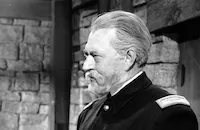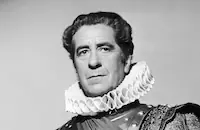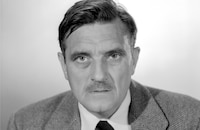In a Lonely Place

Brief Synopsis
Cast & Crew
Nicholas Ray
Humphrey Bogart
Gloria Grahame
Frank Lovejoy
Carl Benton Reid
Art Smith
Film Details
Technical Specs

Synopsis
Screenwriter Dixon Steele is known for his belligerent temper, especially when drinking. This, coupled with his refusal to work on material he dislikes, has kept Dix unemployed for a long time. After meeting his agent, Mel Lippman, at Paul's Restaurant to discuss a possible project, Dix invites Mildred Atkinson, the hat check girl, to his apartment to tell him the plot of the novel he may be assigned to adapt. Mildred dutifully relates the story, and Dix pays her and sends her off to a taxi stand. Early the next morning, Brub Nicolai, a policeman and Dix's former army buddy, takes Dix to the police station, where he learns that Mildred has been brutally murdered. When asked if anyone saw Mildred leaving his apartment, Dix mentions his new neighbor, aspiring actress Laurel Gray. Laurel confirms Dix's story, but the police are not convinced of his innocence, partly because he does not seem upset by the murder and partly because of his violent past. At Captain Lochner's instigation, Brub invites Dix to dinner. After the meal, Dix enacts his theory of how the murder was committed so realistically that he frightens Brub's wife Sylvia. Laurel and Dix later fall in love, and the contented Dix stops drinking and starts writing again. The police have not dropped their investigation of Dix, however, and summon Laurel to the station for more questioning. Laurel is convinced of Dix's innocence, even though Martha, her masseuse, tells her that Dix severely beat his former girl friend. One night, after a beach picnic with Brub and Sylvia, Dix learns that Laurel did not tell him about her second meeting with the police. Sensing Laurel's distrust, a furious Dix drives home so recklessly that he causes an accident and then beats up the other driver. Only Laurel's intervention stops Dix from hitting the driver with a rock. Gradually, Laurel begins to fear Dix's jealousy and his temper. When Dix proposes marriage, Laurel only accepts to avoid an argument with him. Determined to leave Dix, Laurel gives Mel his finished script, without his consent, hoping that if it is well received, Dix will not be as upset by her departure. During a small engagement party at Paul's, Dix angrily slaps Mel when he learns that he gave the script to the producer. Although the producer loved the script, the party is ruined. Later, Brub telephones the restaurant to tell Dix that Henry Kessler, Mildred's boyfriend, has confessed to the murder, but Dix has already left. When Dix learns that Laurel is secretly planning to leave on the day of their wedding, he starts to choke her, but is interrupted by the phone. Brub tells Laurel about Kessler's confession, but it is too late to save her relationship with Dix.

Director

Nicholas Ray
Cast

Humphrey Bogart

Gloria Grahame

Frank Lovejoy

Carl Benton Reid
Art Smith

Jeff Donnell

Martha Stewart

Robert Warwick

Morris Ankrum

William Ching

Steven Geray
Hadda Brooks
Alice Talton
Jack Reynolds
Ruth Warren
Ruth Gillette
Guy Beach
Lewis Howard
Arno Frey
Pat Barton
Cosmo Sardo
Don Hamin
George Davis
Frank Marlowe

Billy Gray
Melinda Erickson
Jack Jahries
David Bond
Myron Healey
Robert Lowell
Robert Davis
Jack Santoro
Tony Layng
Laura Kasley Brooks
Evelyn Underwood
Hazel Boyne
Mike Lally
John Mitchum
Joy Hallward
Allen Pinson
Oliver Cross
June Vincent
Charles Cane
Crew
Rodney Amateau
George Antheil
Earl Bellamy
Clay Campbell
Howard Fogetti
Burnett Guffey
Helen Hunt
Henry S. Kesler
William Kiernan
Viola Lawrence
Robert Lord
Jean Louis
Ray Noble
Edmund H. North
Robert Peterson
Andrew Solt
Morris Stoloff

Photo Collections
Videos
Movie Clip





Hosted Intro




Film Details
Technical Specs

Articles
In a Lonely Place
I died when she left me.
I lived a few weeks while she loved me."
As written by Hollywood screenwriter Dixon Steele (Humphrey Bogart), the above dialogue is not only a summation of a brief romance in Steele's new screenplay but also the short, sad tale of his own roller coaster affair with Laurel Gray (Gloria Grahame), a neighbor in his apartment complex. The couple meet under unusual circumstances. Laurel provides an alibi for Dixon when he is suspected of murdering a restaurant hat-check girl he invited to his apartment for a script reading (Laurel witnessed the woman leaving the apartment alone). Convinced of his innocence, Laurel soon falls deeply in love with Dixon and the two embark on a passionate relationship. But Dixon's volatile, highly paranoid nature begins to emerge through a series of disturbing incidents; during one, he physically attacks a movie producer in a restaurant; in another, he almost beats a man to death in a case of road rage. In the end, Steele's self-destructive behavior condemns him to a private hell of his own making.
Long acknowledged as one of Nicholas Ray's greatest films, In a Lonely Place (1950) features what is probably Gloria Grahame's finest performance (she was married to Ray at the time) and shows us a side of Humphrey Bogart that was rarely exploited on the screen - a man at the boiling point, unable to contain any longer the suppressed rage of a lifetime. According to Goeff Andrew, the author of The Films of Nicholas Ray, "In a Lonely Place is both a product of the years in which it was made (the paranoia, distrust and treachery that colour its portrait of Hollywood are surely linked to the mood prevailing in the United States during the anti-Red witch hunts), and a characteristic Ray study of the destruction of an idealistic romance between lonely outsiders, by the harsh realities of the world around them." Sadly enough, Ray and Grahame were in the middle of a martial breakup when they were filming In a Lonely Place but kept their problems private for fear that the studio would replace Ray with another director. As a result, it's quite possible that Dixon and Laurel's troubled relationship in the film was merely a mirror of Ray and Grahame's off-screen problems and one reason why the couple's doomed romance has the painful ring of truth.
Produced by Santana, Bogart's own production company, In a Lonely Place was based on Dorothy B. Hughes' novel about a serial sex murderer that told the story from the killer's viewpoint. In 1949, however, the Breen Office (Hollywood's self-censoring arm) would never consent to a film version of Hughes' book without some major revisions so screenwriter Andrew Solt set the story in Hollywood, gave Dixon Steele the occupation of screenwriter (he was only posing as a writer in the novel) and avoided the depiction of any on-screen murders with one exception. Still, Ray made further changes to the script, completely revamping the ending.
In an article in The Velvet Light Trap, Ray said that In a Lonely Place was "a very personal film; the place in which it was filmed was the first place I lived in Hollywood. It was my second film with Bogart, and, as some people pointed out, it was the kind of film that made it possible for him to go into The African Queen [1951]. I took the gun out of his hand for the first time in Knock On Any Door [1949], and he was more comfortable this time. The ending which Andrew Solt and I had written became one which I found I couldn't live with, but I had to shoot it. And I did exactly as we had written it, in which Bogart kills the girl, and, as he is writing on the typewriter the last few lines, his old pal from the Army comes in and arrests him and takes him to the police station. Well, if that's not wrapping it up with a nice pink ribbon, I don't know what is; and, as I came closer and closer to the end of it I said, 'Well, today is the day and I have to be ready.' And I kicked everyone off-stage except Bogart, Gloria Grahame, and Art Smith [he plays Dixon's agent]. Even the producer, and [Lauren] Bacall, who had come down to see Bogie work for Columbia for the first time since they were married. And we improvised the ending which is in the film - because romances and marriages always end tragically or with a family. A little avant-garde for its time..."
In a Lonely Place was well-received by most critics but was not a box office hit, though some studio executives at the time felt it might have been had Lauren Bacall been cast in the Gloria Grahame role. Of course, Ray's film is now lauded as a film noir masterpiece and a career highpoint for Bogart. As Robert Sklar wrote in City Boys: Cagney, Bogart, Garfield, "Bogart's performance as Dix Steele shares most of the characteristics of his classic performances except that the tie between the killer and the lover is laid bare, without the romanticism, the genre conventions, or the political ideology which underlay it in previous films....There are no moments for audiences to cheer as he pumps lead into a noxious villain - surely not when he extols the wonderful feeling of crushing a throat, or with his hands around one. In a Lonely Place is a radical demystification of the classic Bogart hero. The role of Dixon Steele is among the most interesting examples of a performer's critical reevaluation of his screen persona, and surely belongs on the list of Bogart's great performances."
Producer: Robert Lord
Director: Nicholas Ray
Screenplay: Edmund H. North, Andrew Solt; based on the novel by Dorothy B. Hughes
Art Direction: Robert Peterson
Cinematography: Burnett Guffey
Editing: Viola Lawrence
Music: George Antheil
Cast: Humphrey Bogart (Dixon Steele), Gloria Grahame (Laurel Gray), Frank Lovejoy (Brub Nicolai), Carl Benton Reid (Capt. Lochner), Robert Warwick (Charlie Waterman), Art Smith (Mel Lippman), Jeff Donnell (Sylvia Nicolai).
BW-94m.
by Jeff Stafford

In a Lonely Place
Quotes
Before I started to go to work at Paul's, I used to think that actors made up their own lines.- Mildred Atkinson
When they get to be big stars, they usually do.- Dixon Steele
Well, he's exciting because he isn't quite normal.- Sylvia Nicolai
Maybe us cops could use some of that brand of abnormality. I learned more about this case in five minutes from him than I did from all of our photographs, tire prints and investigations.- Brub Nicolai
Nobody can call me the things he did.- Dixon Steele
A blind, knuckle-headed squirrel. That's REAL bad.- Laurel Gray
There's no sacrifice too great for a chance at immortality.- Dixon Steele
I was born when she kissed me. I died when she left me. I lived a few weeks while she loved me.- Dixon Steele
Trivia
Notes
According to a October 4, 1949 Los Angeles Times news item, many scenes in this film were shot in Romanoff's café, a well-known Hollywood restaurant. Modern sources, however, report that the film was largely shot on a studio sound stage, and "Paul's Restaurant" was merely "inspired" by Romanoff's. According to modern sources, Ginger Rogers was considered for the role of "Laurel Gray." During filming Nicholas Ray separated from his wife, Gloria Grahame. Ray has been quoted in modern sources as stating that if the studio had known about their separation, he would have been fired, so they kept it secret. The film depicts a realistic romance between two disillusioned people. "Dix" tells "Laurel" that his idea of two people in love is a guy cutting grapefruit and a girl, "sitting over there," half-asleep. At the end of the film "Laurel" quotes a line from his script that reveals "Dix" as a romantic: "I was born when you kissed me. I died when you left me. I lived a few weeks while you loved me."

Miscellaneous Notes
Released in United States on Video April 27, 1989
Released in United States Summer August 1950
Released in United States on Video April 27, 1989
Released in United States Summer August 1950













